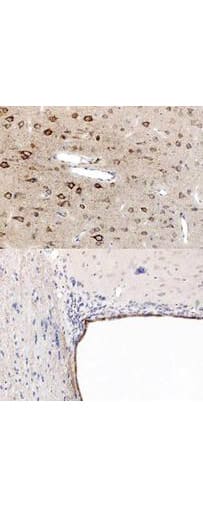PPAR alpha/NR1C1 Antibody - N-terminal
Novus Biologicals, part of Bio-Techne | Catalog # NB600-636

![Western Blot: PPAR alpha/NR1C1 AntibodyN-terminal [NB600-636] Western Blot: PPAR alpha/NR1C1 AntibodyN-terminal [NB600-636]](https://resources.bio-techne.com/images/products/PPAR-alpha-NR1C1-Antibody---N-terminal-Western-Blot-NB600-636-img0015.jpg)
Conjugate
Catalog #
Key Product Details
Species Reactivity
Validated:
Human, Mouse, Rat, Canine
Cited:
Human, Mouse, Rat, Canine, Equine
Applications
Validated:
Chromatin Immunoprecipitation (ChIP), ELISA, Flow Cytometry, Immunocytochemistry/ Immunofluorescence, Immunohistochemistry, Immunohistochemistry-Paraffin, Western Blot
Cited:
Chemotaxis, Immunocytochemistry/ Immunofluorescence, Immunohistochemistry-Paraffin, Western Blot
Label
Unconjugated
Antibody Source
Polyclonal Rabbit IgG
Concentration
Please see the vial label for concentration. If unlisted please contact technical services.
Product Specifications
Immunogen
PPAR alpha/NR1C1 Antibody was prepared from whole rabbit serum produced by repeated immunizations with a synthetic peptide corresponding to a N-Terminal region near amino acids 1-25 of mouse PPAR alpha/NR1C1. (Uniprot: P23204)
Reactivity Notes
A BLAST analysis was used to suggest reactivity with this protein from bovine, dog, golden hamster and boar sources based on 100% homology for the immunogen sequence. Cross reactivity with PPAR alpha/NR1C1 protein from chimpanzee and rhesus monkey may also occur as this sequence shows 88% homology (16/18 identities) with the protein from these sources. Cross reactivity with PPAR alpha/NR1C1 homologues from other sources has not been determined
Human reactivity reported in scientific literature (PMID: 31095524).
Human reactivity reported in scientific literature (PMID: 31095524).
Localization
Nuclear
Specificity
No reactivity is expected against other subtypes of PPAR.
Clonality
Polyclonal
Host
Rabbit
Isotype
IgG
Description
This antibody is directed against mouse PPAR alpha/NR1C1 protein. The product was affinity purified from monospecific antiserum by immunoaffinity purification
Store vial at -20C prior to opening. Aliquot contents and freeze at -20C or below for extended storage. Avoid cycles of freezing and thawing. Centrifuge product if not completely clear after standing at room temperature. This product is stable for several weeks at 4C as an undiluted liquid. Dilute only prior to immediate use.
Store vial at -20C prior to opening. Aliquot contents and freeze at -20C or below for extended storage. Avoid cycles of freezing and thawing. Centrifuge product if not completely clear after standing at room temperature. This product is stable for several weeks at 4C as an undiluted liquid. Dilute only prior to immediate use.
Scientific Data Images for PPAR alpha/NR1C1 Antibody - N-terminal
Western Blot: PPAR alpha/NR1C1 AntibodyN-terminal [NB600-636]
Western Blot: PPAR alpha/NR1C1 Antibody - N-terminal [NB600-636] - Lane 1: NIH/3T3. Load: 10 ug per lane. Primary antibody: PPAR Alpha (N-terminal specific) antibody at 1:1,000 for overnight at 4C. Secondary antibody: Peroxidase rabbit secondary antibody at 1:40,000 for 30 min at RT. Block: Blocking Buffer for Fluorescent Western Blotting at RT for 30 min. Predicted/Observed size: 50 kDa for PPAR Alpha.Immunocytochemistry/ Immunofluorescence: PPAR alpha/NR1C1 Antibody - N-terminal [NB600-636]
Immunocytochemistry/Immunofluorescence: PPAR alpha/NR1C1 Antibody - N-terminal [NB600-636] - Rabbit Anti-PPAR alpha (N-terminal specific) antibody using (A) Mouse NIH/3T3 or (B) Human HEK293 cells fixed with MeOH. (C) Secondary antibody only with NIH/3T3 cells. Anti-PPAR alpha antibody was used at 10 ug/mL, 1h at RT degrees . Secondary antibody: Anti-RABBIT IgG DyLight (R) 488 Conjugated Preadsorbed at 5 ug/ml for 1 h at RT. Staining: PPAR as green fluorescent signal with DAPI (blue) nuclear counterstain.Immunohistochemistry: PPAR alpha/NR1C1 Antibody - N-terminal [NB600-636]
Immunohistochemistry: PPAR alpha/NR1C1 Antibody - N-terminal [NB600-636] - Photomicrographs of cryosections of canine cervical (C8) dorsal root ganglion showing PPARalpha (h-i) immunolabeling. White arrows indicate the Neurotrace labeled nuclei of SGCs which showed PPARalpha immunoreactivity (h). Open arrow indicate autofluorescent pigment. Bar: a-i = 50 um. Image collected and cropped by CiteAb from the following publication (https://www.frontiersin.org/article/10.3389/fvets.2019.00313/full) licensed under a CC-BY license.Applications for PPAR alpha/NR1C1 Antibody - N-terminal
Application
Recommended Usage
Chromatin Immunoprecipitation (ChIP)
1:10-1:500
ELISA
1:75000-1:125000
Flow Cytometry
1:10-1:1000
Immunocytochemistry/ Immunofluorescence
1-5ug/ml
Immunohistochemistry
1:100-1:300
Immunohistochemistry-Paraffin
1:200
Western Blot
1:500-1:2000
Application Notes
This product has been tested in ELISA, Western Blot, Immunohistochemistry, and Immunofluorescence. Expect a single band approximately 52 kDa in size corresponding to PPAR alpha by western blot in the appropriate tissue or cell lysate. A 1:200 dilution is suggested for Immunohistochemistry. Specific conditions for reactivity should be optimized by the end user.
Use in chromatin immunoprecipitation reported in scientific literature (PMID 26586378).
Use in chromatin immunoprecipitation reported in scientific literature (PMID 26586378).
Formulation, Preparation, and Storage
Purification
Immunogen affinity purified
Formulation
0.02 M Potassium Phosphate, 0.15 M Sodium Chloride, pH 7.2
Preservative
0.01% Sodium Azide
Concentration
Please see the vial label for concentration. If unlisted please contact technical services.
Shipping
The product is shipped with polar packs. Upon receipt, store it immediately at the temperature recommended below.
Stability & Storage
Store at -20C. Avoid freeze-thaw cycles.
Background: PPAR alpha/NR1C1
Long Name
Peroxisome Proliferator-activated Receptor alpha
Alternate Names
NR1C1, PPARA
Gene Symbol
PPARA
UniProt
Additional PPAR alpha/NR1C1 Products
Product Documents for PPAR alpha/NR1C1 Antibody - N-terminal
Product Specific Notices for PPAR alpha/NR1C1 Antibody - N-terminal
This product is for research use only and is not approved for use in humans or in clinical diagnosis. Primary Antibodies are guaranteed for 1 year from date of receipt.
Loading...
Loading...
Loading...
Loading...
Loading...
![Immunocytochemistry/ Immunofluorescence: PPAR alpha/NR1C1 Antibody - N-terminal [NB600-636] Immunocytochemistry/ Immunofluorescence: PPAR alpha/NR1C1 Antibody - N-terminal [NB600-636]](https://resources.bio-techne.com/images/products/PPAR-alpha-NR1C1-Antibody---N-terminal-Immunocytochemistry-Immunofluorescence-NB600-636-img0021.jpg)
![Immunohistochemistry: PPAR alpha/NR1C1 Antibody - N-terminal [NB600-636] Immunohistochemistry: PPAR alpha/NR1C1 Antibody - N-terminal [NB600-636]](https://resources.bio-techne.com/images/products/PPAR-alpha-NR1C1-Antibody---N-terminal-Immunohistochemistry-NB600-636-img0022.jpg)
![Western Blot: PPAR alpha/NR1C1 AntibodyN-terminal [NB600-636] Western Blot: PPAR alpha/NR1C1 AntibodyN-terminal [NB600-636]](https://resources.bio-techne.com/images/products/PPAR-alpha-NR1C1-Antibody---N-terminal-Western-Blot-NB600-636-img0014.jpg)
![Immunocytochemistry/ Immunofluorescence: PPAR alpha/NR1C1 Antibody - N-terminal [NB600-636] Immunocytochemistry/ Immunofluorescence: PPAR alpha/NR1C1 Antibody - N-terminal [NB600-636]](https://resources.bio-techne.com/images/products/PPAR-alpha-NR1C1-Antibody---N-terminal-Immunocytochemistry-Immunofluorescence-NB600-636-img0012.jpg)
![Immunohistochemistry-Paraffin: PPAR alpha/NR1C1 Antibody - N-terminal [NB600-636] Immunohistochemistry-Paraffin: PPAR alpha/NR1C1 Antibody - N-terminal [NB600-636]](https://resources.bio-techne.com/images/products/PPAR-alpha-NR1C1-Antibody---N-terminal-Immunohistochemistry-Paraffin-NB600-636-img0006.jpg)
![Immunohistochemistry-Paraffin: PPAR alpha/NR1C1 Antibody - N-terminal [NB600-636] Immunohistochemistry-Paraffin: PPAR alpha/NR1C1 Antibody - N-terminal [NB600-636]](https://resources.bio-techne.com/images/products/PPAR-alpha-NR1C1-Antibody---N-terminal-Immunohistochemistry-Paraffin-NB600-636-img0007.jpg)
![ELISA: PPAR alpha/NR1C1 Antibody - N-terminal [NB600-636] ELISA: PPAR alpha/NR1C1 Antibody - N-terminal [NB600-636]](https://resources.bio-techne.com/images/products/PPAR-alpha-NR1C1-Antibody---N-terminal-ELISA-NB600-636-img0019.jpg)




![Immunocytochemistry/ Immunofluorescence: PPAR alpha/NR1C1 Antibody - N-terminal [NB600-636] - PPAR alpha/NR1C1 Antibody - N-terminal](https://resources.bio-techne.com/images/products/nb600-636_rabbit-polyclonal-ppar-alpha-nr1c1-antibody-31020241616074.jpg)